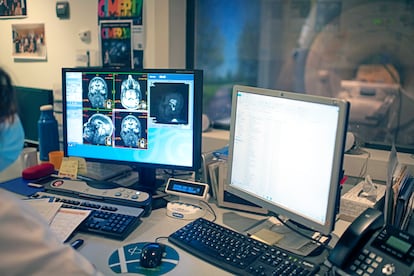Stamp-sized microchip that imitates the human brain could speed up treatments for Alzheimer’s
Advanced brain-on-a-chip technology developed by EU-funded researchers helps make potential treatments for neurological diseases more effective

A human brain-on-a-chip sounds like something from a science fiction film, a gadget powering its cyborg villain.
But chemical and biological engineer Dr Raquel Rodrigues at the International Iberian Nanotechnology Laboratory (INL) in Braga, Portugal, believes that such a device will be key to developing more effective treatments for serious neurological disorders, such as Alzheimer’s.
“The brain is a very complex and puzzling organ,” said Rodrigues. “We need electronic monitoring of cells and experimental parts so we can learn how it works.”
Your brain on a chip
Thanks to research funding from the EU, Rodrigues and fellow researchers at the INL were able to build a unique brain-emulating microchip as part of a two-year research effort called BrainChip4MED that concluded in February 2024.
The research included a 12-month secondment to Brigham and Women’s Hospital, part of Harvard Medical School and pioneers in the development of organs-on-a-chip (OoC) and biosensors.
The ingenious, thumbnail-sized device developed by the researchers looks similar to chips in computers or smartphones, but is much more complex.
The brain-on-a-chip simulates the way the human brain works, using a combination of chemistry, engineering and biology to create a complex micro-biosensor system for the real-time screening of new nanotherapeutics.
Using a technology called microfluidics, the chip features multiple micro-channels — with sizes of tens to hundreds of micrometers — through which fluids can run. This makes it possible to analyze very small quantities of a product and test many samples at the same time, reducing the overall cost of testing.
Protective brain barrier
A central goal of the researchers was to address the problem of how to develop medicines able to cross the so-called blood-brain barrier. This tightly locked layer of cells helps protect the brain from toxins, germs and other harmful substances that could be present in the blood.
Only the very smallest molecules can get through the blood-brain barrier. Although this plays a very important protective role, it has also hindered efforts to develop drugs for the treatment of neurological disorders.
Any medicine meant to treat the brain needs to go through this membrane to reach its target. But short of testing on humans, there are few good ways to determine how well a drug will be able to penetrate into the brain itself.
“Today there are only four commercially available Alzheimer’s drugs, and none of those actually treat Alzheimer’s, they just work on the symptoms,” said Rodrigues.
“That’s because pharmaceutical companies need to invest large amounts of funds in drugs they are unsure will pass the blood-brain barrier. So they don’t,” she said.
A pharmaceutical company might spend millions developing a drug, only to find that it cannot get across the blood-brain barrier. The EU funding for the new brain-emulating chip developed at INL resolves this problem.
Imitating life on a chip
The research team recreated the blood-brain barrier membrane on the chip using bioorganic material.
“That’s what sets our work apart,” said Rodrigues. “We use a bio-membrane that more closely resembles the barrier in our brain. Other devices use physical barriers, made from polymeric components. We think a biological one is superior.”
With this new and improved brain-on-a-chip, researchers will be able to inject medicine under development into the chip to monitor its effects and see how well it is able to penetrate the brain.
The aim is to change the way these kinds of medicines are developed. Today, this type of testing is mostly carried out on animals, but that comes with a range of ethical and practical downsides. These organs-on-a chip microchips offer a potential alternative to traditional animal testing.
“The brain of an animal is different from the brain of a human,” said Rodrigues. “That’s why a lot of medicines under development fail. Animal testing doesn’t necessarily reproduce for humans.”
The stakes are high. Brain disorders are one of the greatest health challenges faced today. It is estimated that around 165 million Europeans are living with a brain disorder. One in three people will suffer from a neurological and/or mental disorder at some point in their lives.
The global cost to European healthcare budgets is estimated to be €800 billion ($820 billion) per year, and this is expected to increase with an aging population.
This includes well-known neurodegenerative diseases such as Alzheimer’s and Parkinson’s disease. It also covers other disorders like epilepsy, depression, stroke, migraines, sleep disorders, traumatic brain injury, pain syndromes and addiction.
Serious step forward
INL is a leading European research institute co-funded by the national governments of Portugal and Spain. It is also supported by the EU and by industry. Dr Manuel Bañobre-López, leader of the Nanomedicine Research Group at INL, supervised the work on the new chip.
“At INL we have extensive expertise in microfluidics, the field that studies the kind of chip we made in BrainChip4MED,” said Bañobre-López.
Still, we might need to wait a bit longer for the brain-on-a-chip to be ready for use, he cautions.
Even though the prototype is ready, further refinement is needed. It will also have to undergo rigorous testing to make sure it can be used for medicines that will eventually be administered to human patients. That process alone will take years.
Nevertheless, the researchers are optimistic.
“We need to combat Alzheimer’s, it’s one of the most problematic neurological diseases in the world,” said Rodrigues. “And to do that, we need to find new drugs. Our technology is a serious step forward in that direction.”
Research in this article was funded by the Marie Skłodowska-Curie Actions (MSCA). The views of the interviewees don’t necessarily reflect those of the European Commission.
This article was originally published in Horizon, the EU Research and Innovation magazine
Sign up for our weekly newsletter to get more English-language news coverage from EL PAÍS USA Edition
Tu suscripción se está usando en otro dispositivo
¿Quieres añadir otro usuario a tu suscripción?
Si continúas leyendo en este dispositivo, no se podrá leer en el otro.
FlechaTu suscripción se está usando en otro dispositivo y solo puedes acceder a EL PAÍS desde un dispositivo a la vez.
Si quieres compartir tu cuenta, cambia tu suscripción a la modalidad Premium, así podrás añadir otro usuario. Cada uno accederá con su propia cuenta de email, lo que os permitirá personalizar vuestra experiencia en EL PAÍS.
¿Tienes una suscripción de empresa? Accede aquí para contratar más cuentas.
En el caso de no saber quién está usando tu cuenta, te recomendamos cambiar tu contraseña aquí.
Si decides continuar compartiendo tu cuenta, este mensaje se mostrará en tu dispositivo y en el de la otra persona que está usando tu cuenta de forma indefinida, afectando a tu experiencia de lectura. Puedes consultar aquí los términos y condiciones de la suscripción digital.
More information
Archived In
Últimas noticias
Venezuela hardens its ‘revolutionary state’ project amid pressure from Trump
Sydney Sweeney, the actress praised by Trump: ‘Women are up against what society wants them to be’
The Bolsonaro surname: An advantage or liability in Brazil’s 2026 presidential elections?
Raúl Rocha, from jet-setting with Miss Universe to arms trafficking and fuel theft
Most viewed
- Reinhard Genzel, Nobel laureate in physics: ‘One-minute videos will never give you the truth’
- Pablo Escobar’s hippos: A serious environmental problem, 40 years on
- Charles Dubouloz, mountaineering star, retires at 36 with a farewell tour inspired by Walter Bonatti
- Why we lost the habit of sleeping in two segments and how that changed our sense of time
- The fall of a prolific science journal exposes the billion-dollar profits of scientific publishing










































